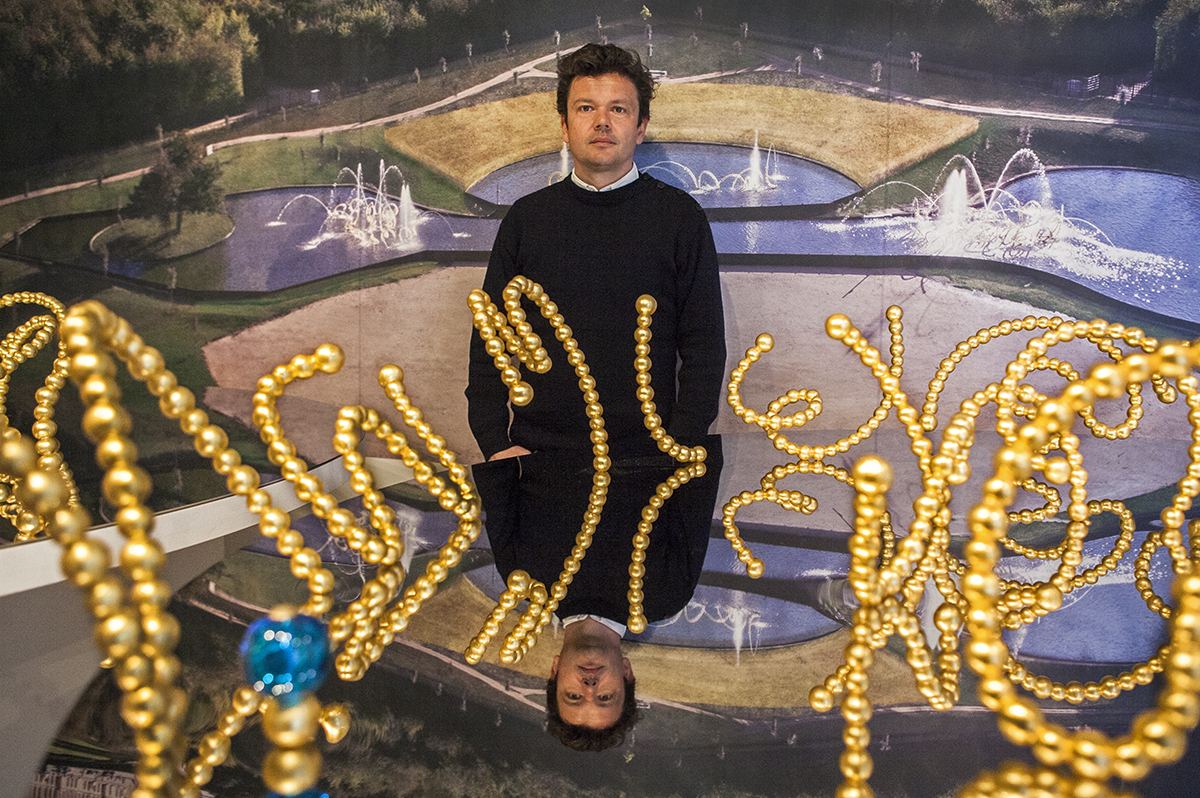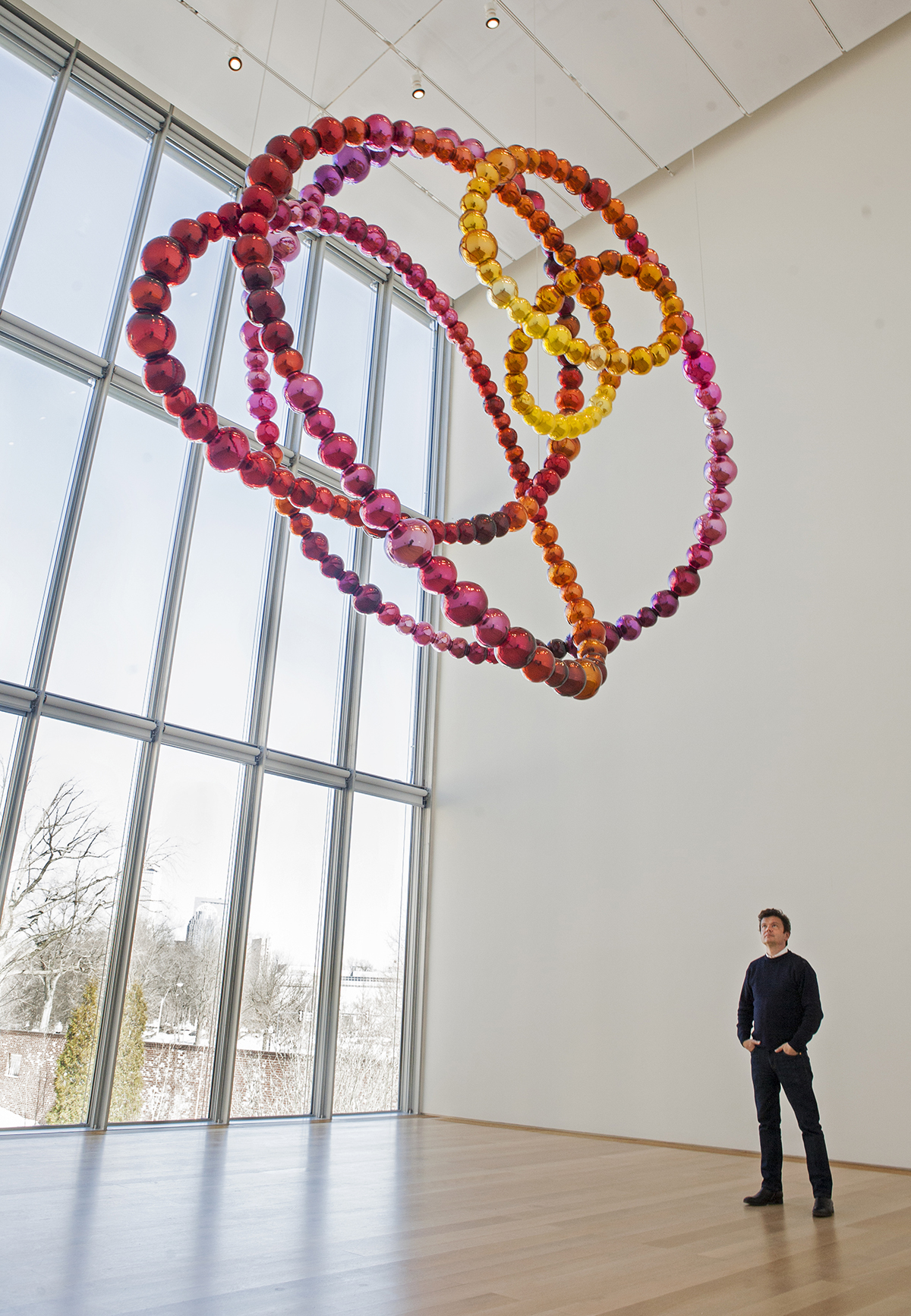Jean-Michel Othoniel Reveals ‘Secret Flower Sculptures’ at the Gardner Museum

Jean-Michel Othoniel with a model of “Les Belles Danses,” three sculptures that will be unveiled at Versailles in May. The artist is previewing the design at a new exhibit at the Gardner. / Photo by Olga Khvan
When the reimagined Water Theater grove, once a favorite garden of Louis XIV, is unveiled at Versailles on May 12, it will feature the first permanent contemporary art installation in 300 years. But the concept for the three-part sculpture didn’t come to artist Jean-Michel Othoniel thousands of miles away, from France, where he lives and works. Instead, it came to him through a series of serendipitous discoveries in Boston, specifically at the Isabella Stewart Gardner Museum.
In the summer of 2011, Othoniel came to Boston to participate in the Gardner’s artist-in-residence program. The Carriage House where the artists usually lived had already been razed to make way for the museum’s expansion, which was to be unveiled the following year. Othoniel had to stay in a nearby hotel instead, but following the program’s tradition, he received rare access to Isabella Gardner’s collection, getting the chance to roam the museum before and after hours.
At the time, Othoniel had already been commissioned by renowned French landscape designer Louis Benech to join him in submitting a proposal to an international competition launched by Versailles to redesign the Water Theater grove. The garden was originally designed in 1661 by André LeNôtre, with sculpture by Charles LeBrun, and Benech felt it was appropriate for the redesign to be headed by another architect-and-artist duo centuries later.
At the Gardner, Othoniel found the freedom to focus on his thoughts rather than the pressure to produce.
“I was invited to stay with no pressure at all,” he says. “In this program, you don’t have to produce something in the end. You just get inspiration from the collection. It’s quite unique in the world to have such a program.”
And so, Othoniel got to exploring art and books both inside the Gardner and out, paying visits to the Museum of Fine Arts and the Harvard Museum of Natural History, where the artist, with his tendency to work with glass and interest in representations of flowers in art, was particularly fascinated by Leopold and Rudolf Blaschka’s famous glass flower models.
But it was at the Boston Public Library that Othoniel made the most significant discovery of his stay. While brainstorming for the Versailles project, he became fascinated with the idea of how the Sun King moved in his garden, and online research led him to an image from The Art of Describing Dance by Raoul-Auger Feuillet, an 18th-century book about ballet choreography during Louis XIV’s reign. The pattern, outlining the steps of a dance, resembled the design of the garden at Versailles. Only three copies of the book exist in the world—one in Paris, one in Montreal, and one in Boston at the BPL.
“So I said, ‘It’s a sign. I have to see this book,'” Othoniel says. “I went to the library, I got a card like when I was a student, and every day I looked at the book, took the chance to really turn the pages. It’s really something very precious.”
While leafing through the book, Othoniel found a connection between its patterns and not only the garden, but also his own drawings, which often form the basis for the glass sculptures he’s acclaimed for.
“There was some obvious coincidence,” he says. “I had this feeling I found the connection between myself, my own world, and the world of Versailles.”

The Boston Public Library’s copy of The Art of Describing Dance, which Othoniel drew inspiration from for his Versailles project. / Photo courtesy of the Isabella Stewart Gardner Museum
Putting this all together, Othoniel came up with the concept for “Les Belles Danses,” three sculptures that would be installed on the reflecting pools of the Water Theater grove redesigned by Benech. The idea would not have been possible, he says, without the passion that American collectors like Isabella Gardner fostered for European culture.
“This project is born here, in Boston, for sure. Being in the States, I found my own roots, which is amazing for me—to find the most prestigious French book about dance in Boston,” he says. “I think as an artist today, I have to make connection with the past. I think it’s something I discovered through this project and through this residency.”
Othoniel and Benech went on to win the competition. While the complete installation will be revealed at Versailles in two months, a preview of Othoniel’s sculptures—models and preliminary drawings—will be on view at the Gardner beginning Thursday, as part of the artist’s “Secret Flower Sculptures” exhibit.
The exhibit will also feature two new site-specific works, which Othoniel was compelled to make after returning to the Gardner and seeing the high ceilings of the museum’s new Hostetter Gallery. The sculptures draw inspiration from two prominent flowers in the Gardner’s horticultural collection—the peony and the rose. The glass “Peony, the Knot of Shame” is hung from the ceiling of the Hostetter Gallery, while the gold aluminum “La Rose des Vents” is placed outside of the museum (temporarily in the garden, but set to be moved to its originally intended location on the roof of the old building, directly across from the Hostetter Gallery in the new wing, once the snow melts).
“The peony is a very strange flower because it’s a flower for the poor. It’s not a rose—the rose is for the rich and the famous. That’s why the rose is in this gold material, and the peony is in glass,” Othoniel says. “[The two sculptures] will form a dialogue between the old building and the new building.”
In tandem with the new exhibit, Othoniel also published a book, The Secret Language of Flowers, essentially a personal tour of the Gardner that highlights the appearance of various flowers in the collections’ paintings and objects, and explains their significance. It’s a book Othoniel has been working on for 35 years, he says, recalling starting to jot down notes about flowers as a teenager. The book was previously published in France, but the revised version, which focuses on the Gardner, marks its first English-language edition.
Within the book’s introduction, Othoniel mentions his design for the project at Versailles. “[It] will surely be my life’s work,” he writes. The project not only connected him to his heritage, but also opened up his artistic vision, inspiring him to delve into public art. He sees both the Versailles project and “La Rose des Vents,” placed outside the Gardner rather than inside, as examples of public art.
“It’s the idea that sculpture is coming to you, going in the street for the people. It’s something I’m beginning to more and more love to do—not just making museum shows, but public art with strong meaning,” he says. “I’m doing the reverse of the street artist, usually starting in the streets and dreaming of going to the museum. I started in the museum, and I want to go to the streets.”

“Peony, the Knot of Shame” hangs from the ceiling of the Hostetter Gallery in the Gardner. / Photo by Olga Khvan
“Jean-Michel Othoniel: Secret Flower Sculptures” will be on view at the Gardner Museum March 12 through September 7. For more information, including related programs, visit gardnermuseum.org.

